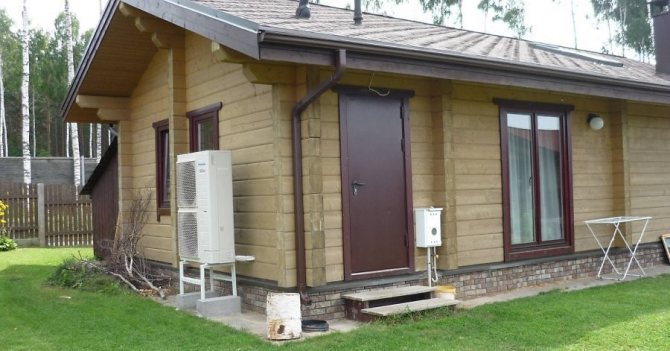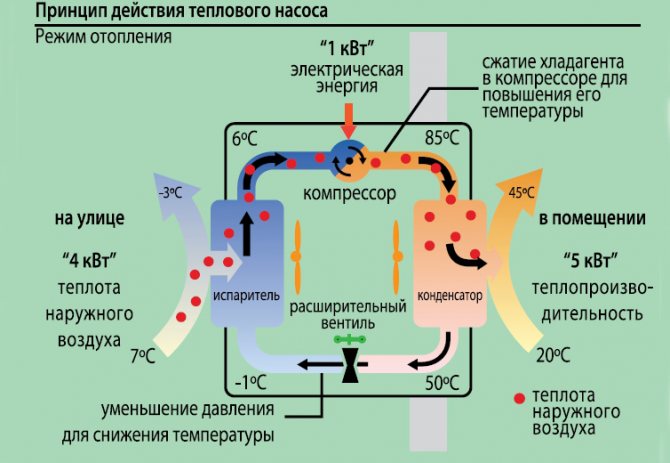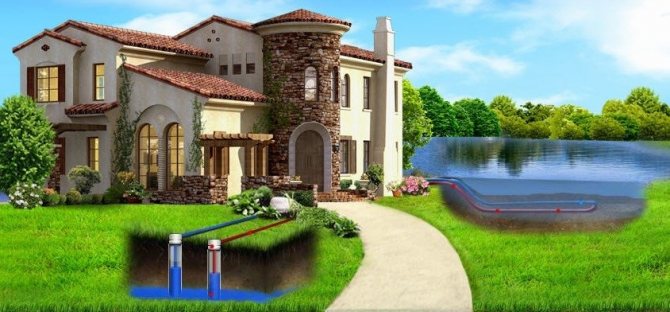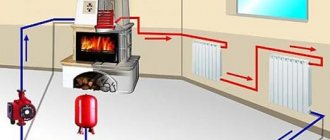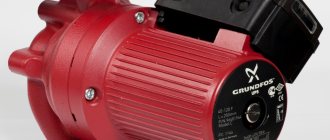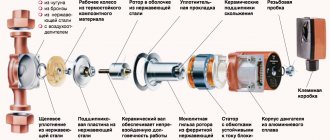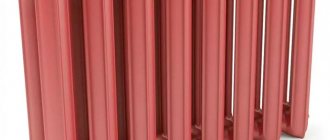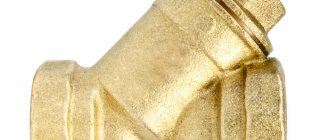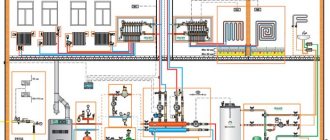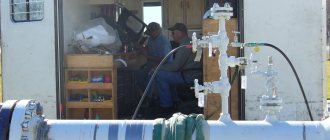Types of heat pump designs

The type of heat pump is usually denoted by a phrase indicating the source medium and heat carrier of the heating system.
There are the following varieties:
- ТН "air - air";
- ТН "air - water";
- TN "soil - water";
- TH "water - water".
The very first option is a conventional split system operating in heating mode. The evaporator is mounted outdoors, and a unit with a condenser is installed inside the house. The latter is blown by a fan, due to which a warm air mass is supplied to the room.
If such a system is equipped with a special heat exchanger with nozzles, the HP type "air-water" will be obtained. It is connected to a water heating system.
The HP evaporator of the "air-to-air" or "air-to-water" type can be placed not outdoors, but in the exhaust ventilation duct (it must be forced). In this case, the efficiency of the heat pump will be increased several times.
Heat pumps of the "water-to-water" and "soil-to-water" type use a so-called external heat exchanger or, as it is also called, a collector for heat extraction.
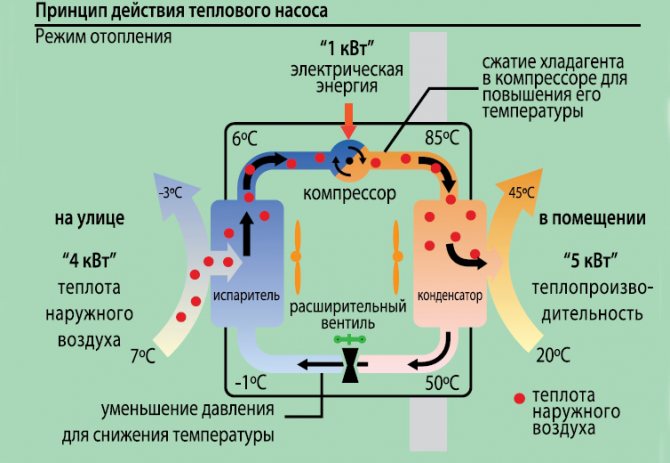

Schematic diagram of the heat pump
This is a long looped tube, usually plastic, through which a liquid medium circulates around the evaporator. Both types of heat pumps represent the same device: in one case, the collector is immersed at the bottom of a surface reservoir, and in the second - into the ground. The condenser of such a heat pump is located in a heat exchanger connected to the hot water heating system.
Connection of heat pumps according to the "water - water" scheme is much less laborious than "soil - water", since there is no need to carry out earthworks. At the bottom of the reservoir, the pipe is laid in the form of a spiral. Of course, for this scheme, only a reservoir is suitable that does not freeze to the bottom in winter.
It's time to substantively study foreign experience
Almost everyone now knows about heat pumps capable of extracting heat from the environment for heating buildings, and if not long ago a potential customer usually asked the bewildered question “how is this possible?”, Now the question “how is it correct? to do? ".
The answer to this question is not easy.
In search of answers to the numerous questions that inevitably arise when trying to design heating systems with heat pumps, it is advisable to turn to the experience of specialists in those countries where heat pumps on ground heat exchangers have been used for a long time.
A visit * to the American exhibition AHR EXPO-2008, which was undertaken mainly in order to obtain information on the methods of engineering calculations for ground heat exchangers, did not bring direct results in this direction, but a book was sold at the ASHRAE exhibition stand, some provisions of which served as the basis for this publications.
It should be said right away that the transfer of the American methodology to domestic soil is not an easy task. For the Americans, things are not the same as in Europe. Only they measure time in the same units as we do. All other units of measurement are purely American, or rather British. The Americans were especially unlucky with heat flux, which can be measured both in British thermal units per unit of time, and in tons of refrigeration, which were probably invented in America.
The main problem, however, was not the technical inconvenience of recalculating the units of measurement adopted in the United States, to which one can get used to it over time, but the absence in the mentioned book of a clear methodological basis for constructing a calculation algorithm. Too much space is given to routine and well-known calculation methods, while some important provisions remain completely undisclosed.
In particular, such physically related initial data for calculating vertical ground heat exchangers, such as the temperature of the fluid circulating in the heat exchanger and the conversion factor of the heat pump, cannot be set arbitrarily, and before proceeding with calculations related to unsteady heat transfer in the ground, it is necessary to determine the dependencies connecting these parameters.
The criterion for the efficiency of a heat pump is the conversion coefficient α, the value of which is determined by the ratio of its thermal power to the power of the compressor electric drive. This value is a function of the boiling points tu in the evaporator and tk of condensation, and in relation to water-to-water heat pumps, we can talk about the liquid temperatures at the outlet from the evaporator t2I and at the outlet from the condenser t2K:
? =? (t2И, t2K). (one)
Analysis of the catalog characteristics of serial refrigerating machines and water-to-water heat pumps made it possible to display this function in the form of a diagram (Fig. 1).


Using the diagram, it is easy to determine the parameters of the heat pump at the very initial stages of design. It is obvious, for example, that if the heating system connected to the heat pump is designed to supply a heating medium with a flow temperature of 50 ° C, then the maximum possible conversion factor of the heat pump will be about 3.5. At the same time, the temperature of the glycol at the outlet of the evaporator should not be lower than + 3 ° С, which means that an expensive ground heat exchanger will be required.
At the same time, if the house is heated by means of a warm floor, a heat carrier with a temperature of 35 ° C will enter the heating system from the condenser of the heat pump. In this case, the heat pump will be able to work more efficiently, for example, with a conversion factor of 4.3, if the temperature of the glycol cooled in the evaporator is about –2 ° C.
Using Excel spreadsheets, you can express function (1) as an equation:
? = 0.1729 • (41.5 + t2I - 0.015t2I • t2K - 0.437 • t2K (2)
If, at the desired conversion factor and a given value of the temperature of the coolant in the heating system powered by a heat pump, it is necessary to determine the temperature of the liquid cooled in the evaporator, then equation (2) can be represented as:
(3)
You can choose the temperature of the coolant in the heating system at the given values of the conversion coefficient of the heat pump and the temperature of the liquid at the outlet of the evaporator using the formula:
(4)
In formulas (2) ... (4) temperatures are expressed in degrees Celsius.
Having identified these dependencies, we can now go directly to the American experience.
Method for calculating heat pumps
Of course, the process of selecting and calculating a heat pump is a technically very complicated operation and depends on the individual characteristics of the object, but it can be roughly reduced to the following stages:
Heat losses through the building envelope (walls, ceilings, windows, doors) are determined. This can be done by applying the following ratio:
Qok = S * (tvn - tnar) * (1 + Σ β) * n / Rt (W) where
tnar - outside air temperature (° С);
tvn - internal air temperature (° С);
S is the total area of all enclosing structures (m2);
n - coefficient indicating the influence of the environment on the characteristics of the object.For rooms in direct contact through floors with the outside environment n = 1; for objects with attic floors n = 0.9; if the object is located above the basement n = 0.75;
β is the coefficient of additional heat loss, which depends on the type of structure and its geographical location β can vary from 0.05 to 0.27;
RT - thermal resistance, is determined by the following expression:
Rt = 1 / αint + Σ (δі / λі) + 1 / αout (m2 * ° С / W), where:
δі / λі is a calculated indicator of thermal conductivity of materials used in construction.
αout is the coefficient of thermal dissipation of the outer surfaces of the enclosing structures (W / m2 * оС);
αin - the coefficient of thermal absorption of the internal surfaces of the enclosing structures (W / m2 * оС);
- The total heat loss of the structure is calculated by the formula:
Qt.pot = Qok + Qi - Qbp, where:
Qi - energy consumption for heating the air entering the room through natural leaks;
Qbp - heat release due to the functioning of household appliances and human activities.
2. Based on the data obtained, the annual consumption of heat energy for each individual object is calculated:
Qyear = 24 * 0.63 * Qt. pot. * ((d * (tvn - tout.) / (tvn - tout.)) (kW / hour per year.) where:
tвн - recommended indoor air temperature;
tnar - outside air temperature;
tout.av - the arithmetic mean value of the outside air temperature for the entire heating season;
d is the number of days of the heating period.
3. For a complete analysis, you will also need to calculate the level of thermal power required to heat the water:
Qgv = V * 17 (kW / hour per year.) Where:
V is the volume of daily heating of water up to 50 ° С.
Then the total consumption of heat energy will be determined by the formula:
Q = Qgv + Qyear (kW / hour per year.)
Taking into account the obtained data, it will not be difficult to choose the most suitable heat pump for heating and hot water supply. Moreover, the calculated power will be determined as. Qtn = 1.1 * Q, where:
Qtn = 1.1 * Q, where:
1.1 is a correction factor indicating the possibility of increasing the load on the heat pump during the period of critical temperatures.
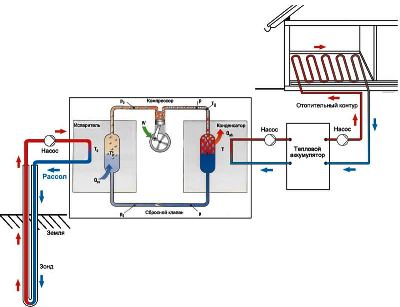

After calculating heat pumps, you can select the most suitable heat pump capable of providing the required microclimate parameters in rooms with any technical characteristics. And given the possibility of integrating this system with a climate control unit, a warm floor can be noted not only for its functionality, but also for its high aesthetic cost.
Formula for counting
Heat loss pathways in the house
The heat pump is able to fully cope with space heating.
To choose the unit that suits you, you should calculate its required power.
First of all, you need to understand the heat balance in the building. For these calculations, you can use the services of specialists, an online calculator or yourself using a simple formula:
R = (k x V x T) / 860, wherein:
R - power consumption of the room (kW / hour); k is the average coefficient of heat loss by the building: for example, equal to 1 - a perfectly insulated building, and 4 - a barrack made of planks; V is the total volume of the entire heated room, in cubic meters; T is the maximum temperature difference between the outside and inside the building. 860 is the value required to convert the resulting kcal to kW.
In the case of a water-to-water geothermal heat pump, it is also necessary to calculate the required length of the circuit that will be in the reservoir. The calculation is even simpler here.
It is known that 1 meter of collector gives about 30 watts. In other words, 1 kW of pump power requires 22 meters of pipes. Knowing the required pump power, we can easily calculate how many pipes we need to make the circuit.
Calculation based on the example of the water-water system
Let's calculate, for example, a house with the following initial data:
- heated area 300 sq.m .;
- ceiling height 2.8 m;
- the building is well insulated;
- the minimum temperature outside in winter is -25 degrees;
- comfortable room temperature +22 degrees.
First of all, we calculate the heated volume of the room: 300 sq.m. x 2.8 m = 840 cubic meters
Then we calculate the value "T": 22 - (-25) = 45 degrees.
We substitute this data into the formula: R = (1 x 840 x 45) / 860 = 43.9 kWh
We have received the required heat pump capacity of 44 kW / h. We can easily determine that for its operation we need a collector with a total length of at least 968 meters.
You may also be interested in an article on how to make a DIY diesel dropper stove: //6sotok-dom.com/dom/otoplenie/pech-kapelnitsa-svoimi-rukami.html
So for a well-insulated room with an area of 300 sq.m. a pump with a capacity of at least 44 kW is suitable. As elsewhere, it is better to make a power reserve of at least 10%. Therefore, it is better to purchase a 48-49 kW unit.
Sooner or later we will all come to the use of alternative energy and we can take the first step today. Using heat pumps, you will reduce your heating costs, become independent from gas or coal suppliers, and preserve the ecology of your home planet.
With the help of this article, you will be able to calculate the parameters of geothermal equipment that will suit your premises. But do not forget that professionals will do their best. And you will always have someone to ask you if the system does not work properly.
Watch a video in which a specialist explains in detail the principles of calculating the power of a heat pump for heating a house:
Heat pump types
Heat pumps are divided into three main types according to the source of low-grade energy:
- Air.
- Priming.
- Water - The source can be groundwater and surface water bodies.
For water heating systems, which are more common, the following types of heat pumps are used:


Air-to-water is an air type heat pump that heats a building by drawing in air from the outside through an external unit. It works on the principle of an air conditioner, only the other way around, converting air energy into heat. Such a heat pump does not require large installation costs, it is not necessary to allocate a plot of land for it and, moreover, to drill a well. However, the efficiency of operation at low temperatures (-25 ° C) decreases and an additional source of thermal energy is required.
The device "ground-water" refers to geothermal and produces heat from the ground using a collector laid at a depth below the freezing of the ground. Also, there is a dependence on the area of the site and the landscape, if the collector is located horizontally. For vertical placement, you will need to drill a well.


"Water-to-water" is installed where there is a body of water or groundwater nearby. In the first case, the reservoir is laid on the bottom of the reservoir, in the second, a well is drilled or several, if the area of the site allows. Sometimes the depth of groundwater is too deep, so the cost of installing such a heat pump can be very high.
Each type of heat pump has its own advantages and disadvantages, if the building is far from the reservoir or the groundwater is too deep, then "water-to-water" will not work. "Air-water" will be relevant only in relatively warm regions, where the air temperature in the cold season does not fall below -25 ° C.
How does a heat pump work
A modern heat pump is very similar to a commonplace refrigerator.
What is a geothermal pump or, in other words, a heat pump? This is equipment capable of transferring heat from the source to the consumer. Let's consider the principle of its operation on the example of the first practical implementation of the idea.
The principle of operation of geothermal pumps became known back in the 50s of the 19th century. In practice, these principles were implemented only in the middle of the last century.
One day, an experimenter named Weber was handling a freezer and accidentally touched a burning condenser tube.He came up with an idea why the heat goes nowhere and does not bring any benefit? Without thinking twice, he lengthened the pipe and put it in the water heating tank.
There was so much hot water that he didn’t know what to do with it. It was necessary to go further - how to heat the air with this simple system? The solution turned out to be very simple and therefore no less ingenious.
Hot water is driven in a spiral through a coil, and then a fan blows warm air around the house. All ingenious is simple! Weber was a measured man, and over time he got the idea of how to do without a freezer. We must extract heat from the earth!
Having buried copper pipes and pumped them with freon (the same gas that is used in refrigerators), he began to receive thermal energy from the depths. We think that with this example, everyone will understand the principle of operation of a heat pump.
We also suggest that you read about the miracle of the diesel fuel oven in the following article:
Method for calculating the power of a heat pump
In addition to determining the optimal energy source, it will be necessary to calculate the heat pump power required for heating. It depends on the amount of heat loss in the building. Let's calculate the power of a heat pump for heating a house using a specific example.
For this, we use the formula Q = k * V * ∆T, where
- Q is heat loss (kcal / hour). 1 kWh = 860 kcal / h;
- V is the volume of the house in m3 (we multiply the area by the height of the ceilings);
- ∆Т is the ratio of the minimum temperatures outside and inside the premises during the coldest period of the year, ° С. Subtract the outside from the inner tº;
- k is the generalized heat transfer coefficient of the building. For a brick building with masonry in two layers k = 1; for a well-insulated building k = 0.6.
Thus, the calculation of the power of the heat pump for heating a brick house of 100 square meters and a ceiling height of 2.5 m, with a ttº difference from -30º outside to + 20º inside, will be as follows:
Q = (100x2.5) x (20- (-30)) x 1 = 12500 kcal / hour
12500/860 = 14.53 kW. That is, for a standard brick house with an area of 100 m, a 14-kilowatt device will be needed.
The consumer accepts the choice of the type and power of the heat pump based on a number of conditions:
- geographical features of the area (proximity to water bodies, the presence of groundwater, a free area for a collector);
- features of the climate (temperature);
- type and internal volume of the room;
- financial opportunities.
Considering all the above aspects, you will be able to make the best choice of equipment. For a more effective and correct selection of a heat pump, it is better to contact specialists, they will be able to make more detailed calculations and provide the economic feasibility of installing the equipment.
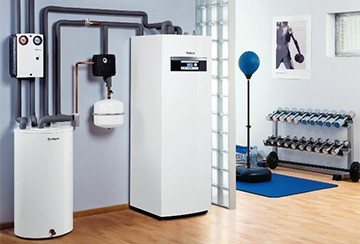

For a long time and very successfully, heat pumps have been used in domestic and industrial refrigerators and air conditioners.
Today, these devices have begun to be used to perform a function of the opposite nature - heating a dwelling during cold weather.
Let's take a look at how heat pumps are used to heat private houses and what you need to know in order to correctly calculate all of its components.
Main varieties


Heat extraction systems. (Click to enlarge)
- air-to-air is, in essence, a conventional air conditioner;
- air-water - we add a heat exchanger to the air conditioner and we are already heating the water;
- earth-water - we bury the collector from the pipes into the ground, and at the outlet we heat the water;
- water-water - pipes are placed in an open or underground reservoir and give off heat to the building heating system.
(You can find a detailed classification of heat pumps for heating in this article).
Heat pump calculation example
We will select a heat pump for the heating system of a one-story house with a total area of 70 sq. m with a standard ceiling height (2.5 m), rational architecture and thermal insulation of the enclosing structures that meet the requirements of modern building codes. For heating the 1st quarter.m of such an object, according to generally accepted standards, it is necessary to spend 100 W of heat. Thus, to heat the whole house you will need:
Q = 70 x 100 = 7000 W = 7 kW of thermal energy.
We choose a heat pump of the "TeploDarom" brand (model L-024-WLC) with a thermal power of W = 7.7 kW. The compressor of the unit consumes N = 2.5 kW of electricity.
Reservoir calculation
The soil on the site allocated for the construction of the collector is clay, the level of groundwater is high (we take the calorific value p = 35 W / m).
The capacity of the collector is determined by the formula:
Qk = W - N = 7.7 - 2.5 = 5.2 kW.
L = 5200/35 = 148.5 m (approx).
Based on the fact that it is irrational to lay a circuit with a length of more than 100 m due to an excessively high hydraulic resistance, we accept the following: the heat pump manifold will consist of two circuits - 100 m and 50 m long.
The area of the site that will need to be allocated for the collector is determined by the formula:
S = L x A,
Where A is the step between adjacent sections of the contour. We accept: A = 0.8 m.
Then S = 150 x 0.8 = 120 sq. m.
Calculations
As you know, heat pumps use free and renewable energy sources: low-potential heat of air, soil, underground, waste and waste waters of technological processes, open non-freezing water bodies. Electricity is spent on this, but the ratio of the amount of heat energy received to the amount of electricity consumed is about 3–6.
More precisely, the sources of low-grade heat can be outdoor air with a temperature of –10 to + 15 ° С, air removed from the room (15–25 ° С), subsoil (4–10 ° С) and groundwater (more than 10 ° C) , lake and river water (0–10 ° С), surface (0–10 ° С) and deep (more than 20 m) soil (10 ° С).
There are two options for obtaining low-potential heat from the soil: laying metal-plastic pipes in trenches 1.2–1.5 m deep or in vertical wells 20–100 m deep. Sometimes pipes are laid in the form of spirals in trenches 2–4 m deep. This significantly reduces the total length of the trenches. The maximum heat transfer from the surface soil is 50–70 kWh / m2 per year. The service life of trenches and wells is over 100 years.
Heat pump calculation example
Initial conditions: It is necessary to choose a heat pump for heating and hot water supply of a two-storey cottage house with an area of 200m2; the temperature of the water in the heating system should be 35 ° C; the minimum temperature of the coolant is 0 ° С. Heat loss of the building is 50W / m2. Clay soil, dry.
Calculation:
Required thermal power for heating: 200 * 50 = 10 kW;
Required heat output for heating and hot water supply: 200 * 50 * 1.25 = 12.5 kW
To heat the building, a WW H R P C 12 heat pump with a power of 14.79 kW (the nearest larger standard size) was selected, which spends 3.44 kW for heating freon. Heat removal from the surface layer of the soil (dry clay) q equals 20 W / m. We calculate:
1) the required thermal power of the collector Qo = 14.79 - 3.44 = 11.35 kW;
2) the total length of pipes L = Qo / q = 11.35 / 0.020 = 567.5 m. To organize such a collector, 6 circuits with a length of 100 m are required;
3) with a laying step of 0.75 m, the required area of the site is A = 600 x 0.75 = 450 m2;
4) total consumption of glycol solution (25%)
Vs = 11.35 3600 / (1.05 3.7 dt) = 3.506 m3 / h,
dt is the temperature difference between the supply and return lines, often taken equal to 3 K. The flow rate per circuit is 0.584 m3 / h. For the collector device, we select a reinforced-plastic pipe of standard size 32 (for example, PE32x2). The pressure loss in it will be 45 Pa / m; the resistance of one circuit is approximately 7 kPa; coolant flow rate - 0.3 m / s.
Calculation of the horizontal heat pump collector
The removal of heat from each meter of the pipe depends on many parameters: the depth of laying, the availability of groundwater, the quality of the soil, etc. Roughly it can be considered that for horizontal collectors it is 20 W / m. More precisely: dry sand - 10, dry clay - 20, wet clay - 25, clay with a high water content - 35 W / m. The difference in the temperature of the coolant in the direct and return lines of the loop in the calculations is usually taken to be 3 ° C. No structures should be erected on the site above the collector, so that the heat of the earth is replenished by solar radiation. The minimum distance between the laid pipes should be 0.7–0.8 m.The length of one trench is usually between 30 and 120 m. It is recommended to use a 25% glycol solution as the primary coolant. In the calculations, it should be taken into account that its heat capacity at a temperature of 0 ° C is 3.7 kJ / (kg K), and its density is 1.05 g / cm3. When using antifreeze, the pressure loss in the pipes is 1.5 times greater than when circulating water. To calculate the parameters of the primary circuit of the heat pump installation, it will be necessary to determine the flow rate of antifreeze: Vs = Qo 3600 / (1.05 3.7 .t), where .t is the temperature difference between the supply and return lines, which is often taken equal to 3 K, and Qo is the thermal power received from a low-potential source (ground). The latter value is calculated as the difference between the total power of the heat pump Qwp and the electric power spent on heating the freon P: Qo = Qwp – P, kW. The total length of the collector pipes L and the total area of the section under it A are calculated by the formulas: L = Qo / q, A = L · da. Here q is the specific (from 1 m pipe) heat removal; da is the distance between the pipes (laying step).
Probe calculation
When using vertical wells with a depth of 20 to 100 m, U-shaped metal-plastic or plastic pipes (with diameters above 32 mm) are immersed in them. As a rule, two loops are inserted into one well, after which it is filled with cement mortar. On average, the specific heat output of such a probe can be taken equal to 50 W / m. You can also focus on the following data on heat output:
* dry sedimentary rocks - 20 W / m;
* stony soil and water-saturated sedimentary rocks - 50 W / m;
* rocks with high thermal conductivity - 70 W / m;
* groundwater - 80 W / m.
The soil temperature at a depth of more than 15 m is constant and is approximately + 10 ° С. The distance between the wells should be more than 5 m. If there are underground currents, the wells should be located on a line perpendicular to the flow. The selection of pipe diameters is carried out based on the pressure loss for the required coolant flow rate. The calculation of the liquid flow rate can be carried out for t = 5 ° С. Calculation example. The initial data are the same as in the above calculation of the horizontal collector. With a specific heat removal of the probe of 50 W / m and the required power of 11.35 kW, the length of the L probe should be 225 m. .0); in total - 6 circuits, 150 m each.
The total flow rate of the coolant at .t = 5 ° С will be 2.1 m3 / h; flow rate through one circuit - 0.35 m3 / h. The circuits will have the following hydraulic characteristics: pressure loss in the pipe - 96 Pa / m (heat carrier - 25% glycol solution); loop resistance - 14.4 kPa; flow speed - 0.3 m / s.
Heat pump payback
When it comes to how long it takes a person to return his money invested in something, it means how profitable the investment itself was. In the field of heating, everything is quite difficult, since we provide ourselves with comfort and heat, and all systems are expensive, but in this case, you can look for such an option that would return the money spent by reducing costs during use. And when you start looking for a suitable solution, you compare everything: a gas boiler, a heat pump or an electric boiler. We will analyze which system will pay off faster and more efficiently.
The concept of payback, in this case, the introduction of a heat pump to modernize the existing heat supply system, to put it simply, can be explained as follows:
There is one system - an individual gas boiler, which provides autonomous heating and hot water supply. There is a split-system air conditioner that provides one room with cold. Installed 3 split systems in different rooms.
And there is a more economical advanced technology - a heat pump that will heat / cool houses and heat water in the right quantities for a house or apartment. It is necessary to determine how much the total cost of equipment and initial costs have changed, and also to estimate how much the annual operating costs of the selected types of equipment have decreased. And to determine in how many years, with the resulting savings, more expensive equipment will pay off.Ideally, several proposed design solutions are compared and the most cost-effective one is selected.
We will carry out the calculation and vyyaski, what is the payback period of a heat pump in Ukraine
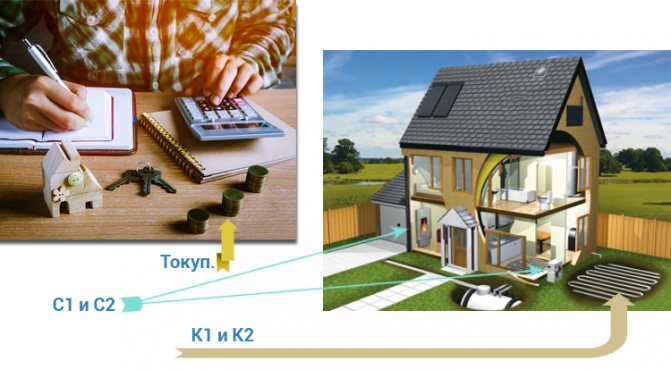

Let's consider a specific example
- The house is on 2 floors, well insulated, with a total area of 150 sq. M.
- Heat / heating distribution system: circuit 1 - underfloor heating, circuit 2 - radiators (or fan coil units).
- A gas boiler was installed for heating and hot water supply (DHW), for example 24kW, double-circuit.
- Air conditioning system from split systems for 3 rooms of the house.
Annual costs for heating and water heating


| Max. heating capacity of heat pump for heating, kW | 19993,59 |
| Max. power consumption of heat pump when operating for heating, kW | 7283,18 |
| Max. heating capacity of heat pump for hot water supply, kW | 2133,46 |
| Max. power consumption of the heat pump when operating on hot water supply, kW | 866,12 |
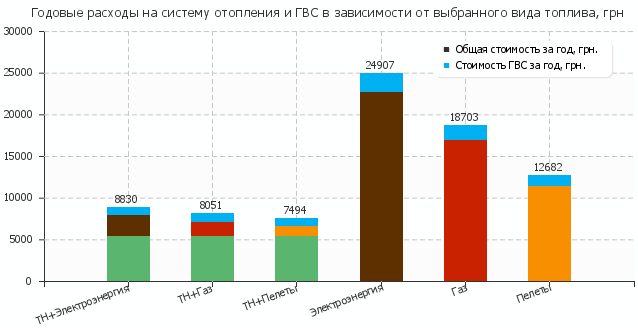

- The approximate cost of a boiler room with a 24 kW gas boiler (boiler, piping, wiring, tank, meter, installation) is about 1000 Euro. An air conditioning system (one split system) for such a house will cost about 800 euros. In total with the arrangement of the boiler house, design work, connection to the gas pipeline network and installation work - 6100 euros.
- The approximate cost of the Mycond heat pump with additional fan coil system, installation work and connection to the mains is 6,650 euros.
- Investment growth is: К2-К1 = 6650 - 6100 = 550 euros (or about 16500 UAH)
- Reducing operating costs is: C1-C2 = 27252 - 7644 = 19608 UAH.
- Payback period Tocup. = 16500/19608 = 0.84 years!
Ease of use of the heat pump
Heat pumps are the most versatile, multifunctional and energy efficient equipment for heating a home, apartment, office or commercial facility.
An intelligent control system with weekly or daily programming, automatic switching of seasonal settings, maintaining the temperature in the house, economy modes, controlling a slave boiler, boiler, circulation pumps, temperature control in two heating circuits, is the most advanced and advanced. Inverter control of the operation of the compressor, fan, pumps, allows maximum energy savings.
Heat pump operation when working according to the ground-water scheme
The collector can be buried in three ways.
Horizontal option
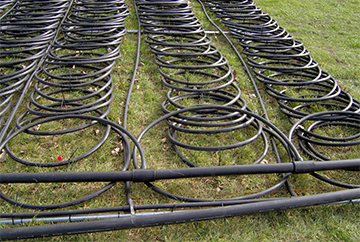

Pipes are laid in trenches like a snake to a depth exceeding the depth of soil freezing (on average - from 1 to 1.5 m).
Such a collector will require a plot of land of a sufficiently large area, but any homeowner can build it - no skills, other than the ability to work with a shovel, are needed.
However, it should be taken into account that the construction of a heat exchanger by hand is a rather laborious process.
Vertical option
The reservoir pipes in the form of loops having the shape of the letter “U” are immersed in wells with a depth of 20 to 100 m. If necessary, several such wells can be built. After installing the pipes, the wells are filled with cement mortar.
The advantage of a vertical collector is that a very small area is needed for its construction. However, there is no way to drill wells more than 20 m deep on your own - you will have to hire a team of drillers.
Combined option
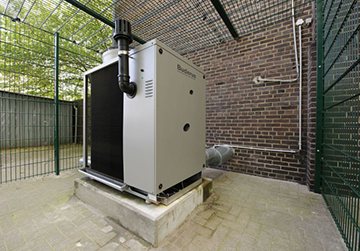

This collector can be considered a kind of horizontal collector, but much less space is required for its construction.
A round well is dug on the site with a depth of 2 m.
The heat exchanger tubes are laid in a spiral, so that the circuit is like a vertically installed spring.
Upon completion of the installation work, the well is filled up. As in the case of a horizontal heat exchanger, all the necessary amount of work can be done by hand.
The collector is filled with antifreeze - antifreeze or ethylene glycol solution.To ensure its circulation, a special pump is cut into the circuit. Having absorbed the heat of the soil, the antifreeze goes to the evaporator, where heat exchange takes place between it and the refrigerant.
It should be borne in mind that unlimited heat extraction from the soil, especially when the collector is located vertically, can lead to undesirable consequences for the geology and ecology of the site. Therefore, in the summer period, it is highly desirable to operate the heat pump of the "soil - water" type in a reverse mode - air conditioning.
The gas heating system has many advantages, and one of the main ones is the low cost of gas. How to equip home heating with gas, you will be prompted by the heating scheme of a private house with a gas boiler. Consider the heating system design and replacement requirements.
Read about the features of choosing solar panels for home heating in this topic.
Calculation of the horizontal heat pump collector
The efficiency of a horizontal collector depends on the temperature of the medium in which it is immersed, its thermal conductivity, and the area of contact with the pipe surface. The calculation method is rather complicated, therefore, in most cases, averaged data are used.
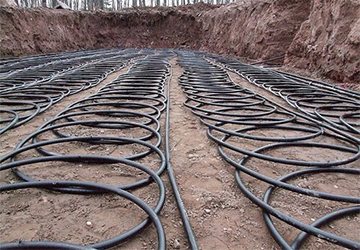

It is believed that each meter of the heat exchanger provides the HP with the following heat output:
- 10 W - when buried in dry sandy or rocky soil;
- 20 W - in dry clay soil;
- 25 W - in wet clay soil;
- 35 W - in very damp clay soil.
Thus, to calculate the length of the collector (L), the required thermal power (Q) should be divided by the calorific value of the soil (p):
L = Q / p.
The values given can only be considered valid if the following conditions are met:
- The plot of land above the collector is not built-up, not shaded or planted with trees or bushes.
- The distance between adjacent turns of the spiral or sections of the "snake" is at least 0.7 m.
How heat pumps work
Any heat pump has a working medium called a refrigerant. Usually freon acts in this capacity, less often ammonia. The device itself consists of only three components:
The evaporator and the condenser are two tanks, which look like long curved tubes - coils. The condenser is connected at one end to the compressor outlet, and the evaporator to the inlet. The ends of the coils are joined and a pressure reducing valve is installed at the junction between them. The evaporator is in contact - directly or indirectly - with the source medium, and the condenser is in contact with the heating or DHW system.


How the heat pump works
The HP operation is based on the interdependence of gas volume, pressure and temperature. Here's what happens inside the unit:
- Ammonia, freon or other refrigerant, moving along the evaporator, heats up from the source medium, for example, to a temperature of +5 degrees.
- After passing through the evaporator, the gas reaches the compressor, which pumps it to the condenser.
- The refrigerant discharged by the compressor is held in the condenser by a pressure reducing valve, so its pressure is higher here than in the evaporator. As you know, with increasing pressure, the temperature of any gas increases. This is exactly what happens with the refrigerant - it heats up to 60 - 70 degrees. Since the condenser is washed by the coolant circulating in the heating system, the latter also heats up.
- The refrigerant is discharged in small portions through the pressure reducing valve to the evaporator, where its pressure drops again. The gas expands and cools down, and since part of the internal energy was lost by it as a result of heat exchange at the previous stage, its temperature drops below the initial +5 degrees. Following the evaporator, it heats up again, then it is pumped into the condenser by the compressor - and so on in a circle. Scientifically, this process is called the Carnot cycle.
But the heat pump still remains very profitable: for each spent kW * h of electricity, it is possible to obtain from 3 to 5 kW * h of heat.
Self-made accessories for heating system with heat pump
It is quite difficult for an ordinary homeowner to compete with industrial heat pumps of domestic and foreign manufacturers, however, its installation and manufacturing of individual units is not an impossible job. The main task when installing a heat pump is the correctness of calculations, because in case of an error, the system can have low efficiency and become ineffective.
Compressor
For installation, you will need a new or used one. the compressor is in working order with an unused resource of suitable power. Typical compressor power should be 20 - 30% of the calculated one, you can use standard factory units for refrigerators or spiral air conditioners, which have a higher efficiency compared to piston devices.
Evaporator and condenser
To cool and heat liquids, they are usually passed through copper pipes placed in a container with a heat exchanger. To increase the cooling area, the copper pipe is arranged in the form of a spiral, the required length is calculated using the formula for calculating the area divided by the section. The volume of the heat exchange tank is calculated based on the implementation of effective heat exchange, the usual average is about 120 liters. For a heat pump, it is rational to use pipes for air conditioners, which initially have a spiral shape and are implemented in coils.


Fig. 3 Copper tube and tank for heat exchanger
Many heat pump manufacturers have replaced this method of constructing heat exchangers with a more compact one, using heat exchange according to the "pipe in pipe" principle. The standard diameter of the plastic pipe for the evaporator is 32 mm, a copper pipe with a diameter of 19 mm is placed in it, the evaporator is thermally insulated, the total length of the heat exchanger is about 10 - 12 m. For the condenser, 25 mm can be used. metal-plastic pipe and 12.7 mm. copper.
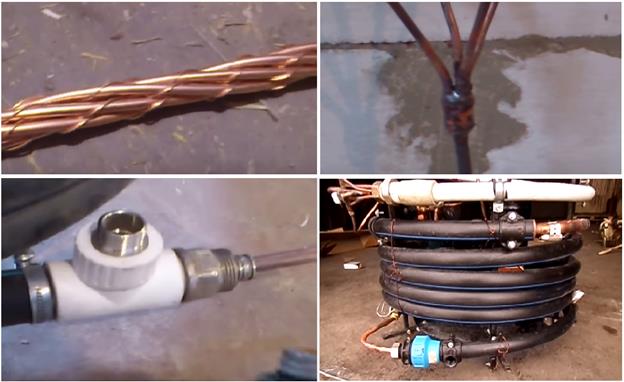

Fig 4. Assembly and appearance of a heat exchanger made of copper and plastic pipes
To increase the area and efficiency of the heat exchanger, some craftsmen twist a braid of several copper pipes of small diameter, transfer them with a thin wire and place the structure in plastic. This makes it possible to obtain a heat exchange area of about 1 cubic meter on a 10-meter section.
Thermostatic expansion valve
The right device controls the fill level of the evaporator and is largely responsible for the performance of the entire system. For example, if the flow of refrigerant is too high, it will not have time to completely evaporate, and droplets of liquid will enter the compressor, leading to disruption of its operation and a decrease in the outlet gas temperature. Too small amount of freon in the evaporator after increasing the temperature in the compressor will not be enough to warm up the required volume of water.
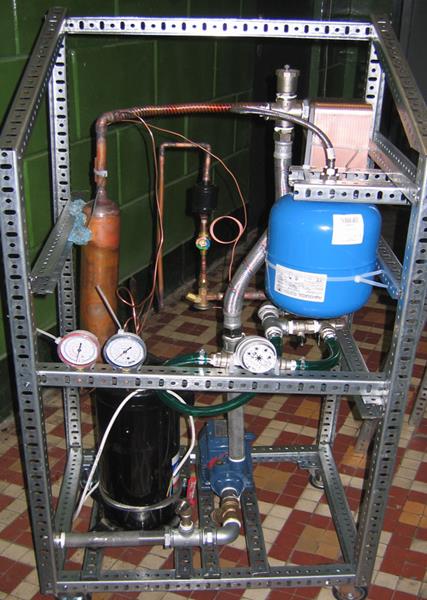

Fig. 5 Basic equipment for a heat pump
Sensors
For ease of use, operation control, fault detection and system configuration, built-in temperature sensors are required. Information is important at all stages of the system's functioning, only with its help, according to the formulas, it is possible to establish the most important parameter of the installed equipment for water heat pumps - the COP efficiency indicator.
Pump equipment
When heat pumps are in operation, the intake and supply of water from a well, a well or an open reservoir is carried out using water pumps. Submersible or surface types can be used, usually their power is low, 100 - 200 watts are enough to supply water. To control the operation, protect the pumps and the system, filters, a pressure gauge, water meters and the simplest automation are additionally installed.
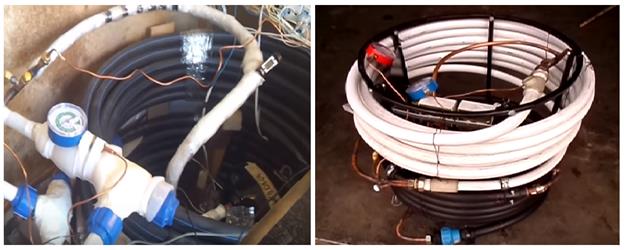

Fig. 6 Appearance of a self-assembled heat pump
Do-it-yourself assembly of heat pumping equipment does not present great difficulties in the ability to handle a special tool for welding and soldering copper. The work performed will help to save significant funds - the cost of components will be about $ 600. That is, the purchase of industrial equipment will cost 10 times more (about 6000 USD). A self-assembled structure, when correctly calculated and configured, has an efficiency (COP) of about 4, which corresponds to industrial designs.
We advise you to read: Do-it-yourself heat pump working options
maybe
